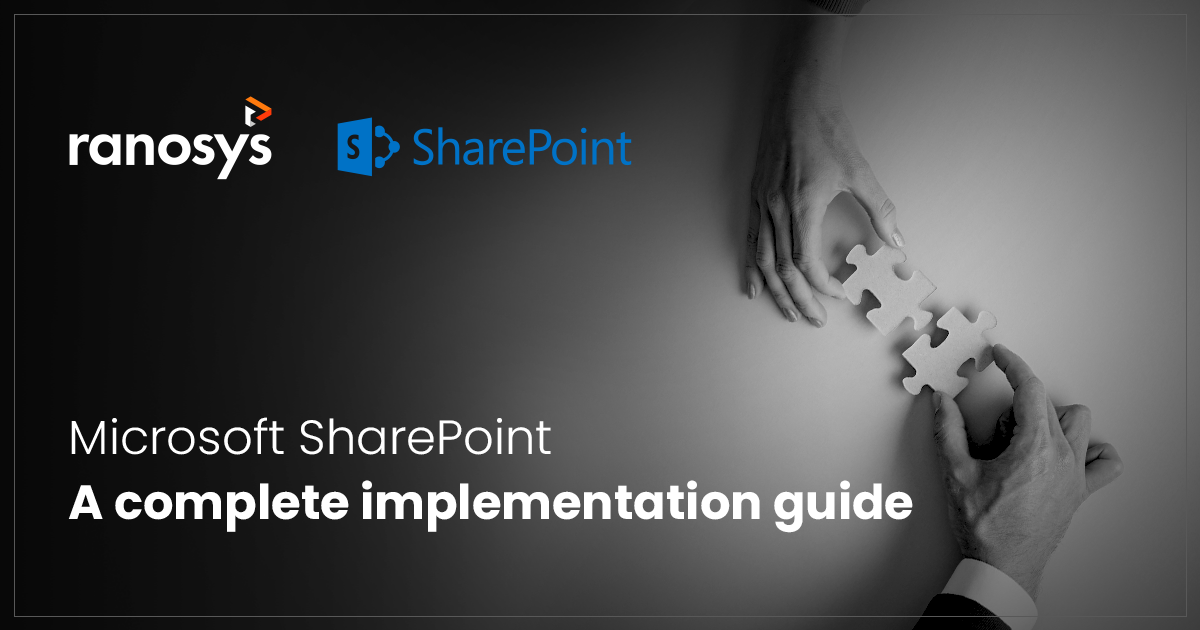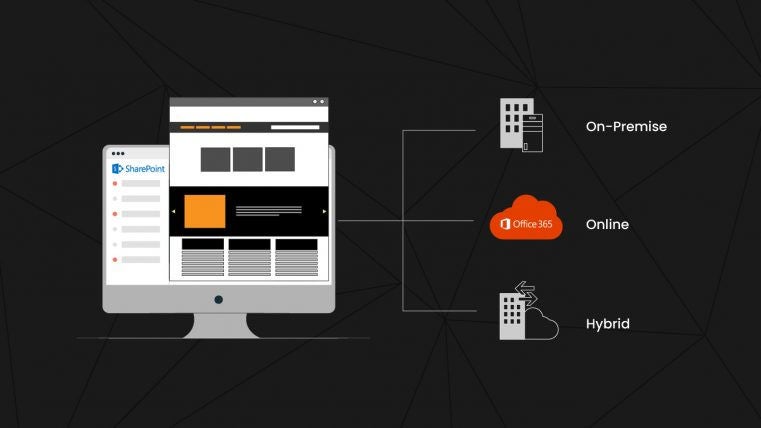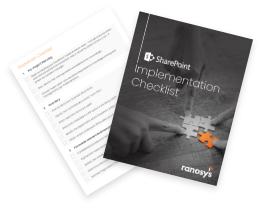What you choose for your organization depends on your needs, business complexities and overall requirement. However, what ties all of these in one thread is the seamlessness they bring to a business.
Microsoft SharePoint makes business processes run smoother and helps the team collaborate with more efficiency. If you’re still unsure about how positively Microsoft SharePoint can impact your business, let us give you a better glimpse.
Why is Microsoft SharePoint Important for Businesses?
- Simple Way for Powerful Collaborations: With Microsoft SharePoint, your team gets a platform to collaborate and be in touch with each other from anywhere, at any time. It provides an easy-to-navigate interface with powerful functionalities that aids your team’s performance with minimum efforts on their side.
- Improve Business Processes: With its built-in validations, SharePoint helps you collect vital information at one place from all stakeholders. It also has interactive components like BI dashboards which show scorecards, graphs, and KPIs in a simplified and unified manner. With all these features, your team finds the right information to make informed decisions and improve business processes.
- Gives a Unified, Single Platform: SharePoint has a scalable architecture for employing web services. It can even include interoperability standards like XML and Simple Object Access Protocol (SOAP). It has a rich library of APIs for lists and documents. With this, you can easily integrate your existing non-Microsoft IT system without any hassle.
- Provides Secure Space for Knowledge Management and Sharing: SharePoint provides a safe repository for documents, historical data, and knowledge nuggets. By using it in your internal system, your team will get the benefit of continuous, safe and authentic organizational knowledge gathered over time from verified sources.
There’s no doubt that implementation of Microsoft SharePoint services can help a business achieve operational efficiency. In fact, it has helped many industries like BFSI streamline their functions. However, companies face difficulties when it comes to Microsoft SharePoint implementation. In this blog, we will provide you with a comprehensive guide to help you implement it in your organization.
Factors That Affect Microsoft SharePoint Implementation in Your Business
Budget Constraint
There’s no fixed estimation for the cost of SharePoint as it depends on various factors like whether you choose on-premise or online, whether you outsource it or not.
However, you can assume the project cost to be at least $25000. Besides this initial cost, there are many hidden costs involved. Let us explain them to you.
- Licensing Cost: There are many licensing options made available by Microsoft for SharePoint and Office 365. You can choose your subscription plans based on storage space and the monthly plans start with as low as $5 per user per month. You may also need to obtain a license for MS SQL and MS Windows Server as they don’t align with SharePoint. (To understand more about pricing, please refer here).
- Security Tools: You will also need to subscribe to particular malware protections and backup products. Of course, you can also choose third-party solutions to protect your system.
- Hardware and Infrastructure: If you are opting for SharePoint On-Premise, then you may also need servers like Microsoft SQL Server, SharePoint Web front-end, disk storage, networking hardware, etc.
- IT Staff: With On-Premise functionality, you may need to hire IT specialists. However, the number and expertise of these specialists completely depend on the complexity of development and configuration. If you opt for basic functionalities, then the cost of maintenance and support will be lower and vice-versa.
- Third-Party Software: Along with SharePoint, you may also need to spend money on third-party solutions required to carry out tasks on SharePoint.
Phases of Development
Phase I: Determining the Vision:
Ideally, you must begin by assessing the needs of your organization and how Microsoft Sharepoint implementation will address them.
- Find Your Deployment Members: Before the implementation, you need to identify your major stakeholders in the implementation process. Your key business decision-makers, IT architects and end-users are the groups that will benefit the most with this implementation. Thus, their presence and thoughts are of the utmost importance.
- Determine Your Business Needs: MS SharePoint is used for multiple purposes. From content management to document storage, you can fulfill many goals with it. Thus, you need to carefully map your objectives before you begin the process.
Phase II: Onboarding the Resources:
At this step, you will begin the rollout process of SharePoint. But before you begin, certain details need to be taken care of. They are as follows:
- Technical Planning: The first step will be to find out a way to integrate your current content into SharePoint. Thankfully, Microsoft offers a variety of tools related to SharePoint which can simplify your migration process. Some of them are Microsoft Fastrack, SharePoint Migration Tool, PowerShell, Migration Manager, etc. Furthermore, you will also need to check your internet bandwidth and security checks before you start the rollout.
- Carry a Pilot Test: Introducing a new technology becomes easier when you have the support of a few key stakeholders. Before you introduce the technology to the entire organization, you must run a pilot test. You can ask the participants to carry out routine tasks like storing and accessing the content, sharing the material, etc. to check its usefulness. Their reviews are important to make final tweaks before you introduce the technology to the organization.
- Roll-Out to a Single Department: Before the organization-level rollout, you should roll-out the implementation of SharePoint to a single department or business unit. During this phase, you will direct this particular business unit to migrate their documents to SharePoint, train the end-users to use it properly and take their feedback for making any changes, if required.
Phase III: Getting the Right Value:
This is the final phase of the Microsoft SharePoint implementation where you will finally roll-out the technology to the entire organization. This process also has two phases where first you implement it and then, you drive its successful adoption amongst users.
- Roll-Out to the Organization: Your final roll-out will have all the changes implemented after the pilot test and the single unit roll-out. Before you finally ask people to start using SharePoint, it’s important to train them and provide them with manuals. Also, you must be ready for feedback as it is an essential part of change management.
- Drive SharePoint’s Adoption: Adoption of a new technology requires commitment from the leadership. They must be the change leaders and inspire the team to use the technology to its full potential. You can identify a few resources as your change champions and reward them to encourage people.
Microsoft SharePoint helps bring your entire organization together and makes collaboration effective and efficient. But making this implementation successful depends on how well it is deployed and how your team uses it.
Let us show you how you can help your employees get used to SharePoint.
How to Make Your Team Adopt SharePoint Easily
No technology can be used fully unless its users adopt it well. And, it is the top management’s responsibility to ensure that your team makes the transition easier. Some of the tips that you can follow are –
- Gradual Implementation: As we have discussed this already in detail, the introduction of a new technology or system is always easier when it’s done in phases. It helps the team in understanding the new process and also provides an opportunity to the leaders for correcting the loopholes, if any.
- User-Friendly UI/UX: The main purpose of implementing SharePoint in your organization is to make collaboration simpler for your team. A user-friendly UI/UX ensures that your team utilizes SharePoint to its full advantage. An interactive and intuitive UI/UX makes navigation easier and helps users adapt to it quickly.
- Simple Features: Keeping the features simple and easy-to-understand is another way to engage your team. The key is to only include features that are essential for your organizational needs and remove everything unnecessary.
- Right Training: It is the management’s responsibility to ensure that the team is properly trained to use SharePoint. From demos to user manuals, there are many ways to train your organization as you plan to implement Microsoft SharePoint.








